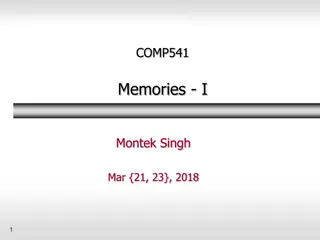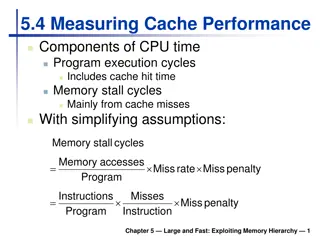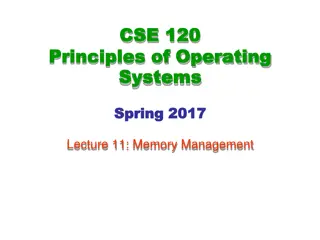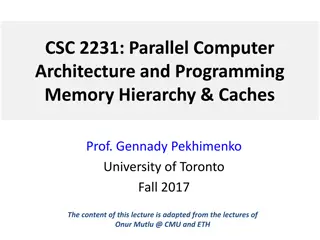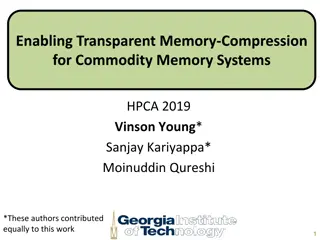Memory Hierarchy for Improved Algorithm Performance
In the world of data structures and algorithms, understanding the memory hierarchy is essential for optimizing performance. By delving into the intricacies of memory access and latency, programmers can design algorithms that leverage the speed and efficiency of different memory levels. This knowledge allows for faster execution of operations by capitalizing on cache utilization and minimizing disk accesses. Dive into the nuances of memory hierarchy and unlock the potential for enhanced algorithm efficiency.
Uploaded on Mar 01, 2025 | 1 Views
Download Presentation

Please find below an Image/Link to download the presentation.
The content on the website is provided AS IS for your information and personal use only. It may not be sold, licensed, or shared on other websites without obtaining consent from the author.If you encounter any issues during the download, it is possible that the publisher has removed the file from their server.
You are allowed to download the files provided on this website for personal or commercial use, subject to the condition that they are used lawfully. All files are the property of their respective owners.
The content on the website is provided AS IS for your information and personal use only. It may not be sold, licensed, or shared on other websites without obtaining consent from the author.
E N D
Presentation Transcript
CSE373: Data Structures & Algorithms Lecture 26: Memory Hierarchy and Locality Kevin Quinn, Fall 2015 1
Why do we need to know about the memory Hierarchy? One of the assumptions that Big-Oh makes is that all operations take the same amount of time This is not quite correct.
Example 8 16 x 0 y 1 2 1000 int x = 8; int y = 2 * x; z[0] 0 0 z[1] 1001 int[] z = new int[1000] int val = z[0] + z[1] + z[999]; 1999 3000 3001 z[999] top 0 ListNode top = new ListNode(7); top.next = new ListNode(24); ListNode temp = top.next; address 5000 val 5000 7 next val next 5001 7000 7001 address 7000 24 null
Definitions Cycle (for our purposes): the time is takes to execute a single simple instruction (for example, add 2 registers together) Memory Latency: The time it takes to access memory
Moral of the story It is much faster to do: 5 million arithmetic ops than 1 disk access 25000 L2 cache accesses than 1 disk access 400 main memory accesses then 1 disk access Why though? Physical realities (speed of light, closeness to CPU) Cost (price per byte of different technologies) Disks get much bigger but not much faster Spinning at 7200 RPM account for much of the slowness, spinning hard disks are unlikely to get much faster. What about SSDs? Speedup at higher levels (i.e. a faster processor) makes lower level accesses relatively slower. Yikes.
What can we do to optimize? Hardware automatically moves data into caches from main memory Replacing items already there Algorithms are much faster if data fits in the cache Disk accesses are abstracted away by the operating system Code just runs but sometimes it s worth designing algorithms/data structures with knowledge of the memory hierarchy
Locality Temporal Locality (locality in time) If an item (a location in memory) is referenced, that same location will tend to be referenced again soon Spatial Locality (locality in space) If an item is referenced, items whose addresses are close by will tend to be referenced soon as well
How does data move up the hierarchy? Moving data up the hierarchy is slow because of latency (distance to travel) Since we are making a trip anyway, might as well carpool! Get a block of data in the same time it takes to get a byte Send nearby memory Because its cheap and easy And spatial locality says it will be asked for soon! Once we move something to the cache, keep it around for a while, no rush to get rid of it! (Temporal Locality)
Cache Facts Each level is a sub-set of the level below Definitions Cache hit: address requested already in the cache Cache miss: address request NOT in the cache Block of page size: the number of contiguous bytes moved from disk to memory Cache line size: the number of contiguous bytes moved from memory to the cache
Examples x = a + 6; miss y = a + 5; hit Temporal z = 8 * a; hit Locality x = a[0]; miss y = a[1] + 5; hit Spatial z = 8 * a[2]; hit Locality
Locality in Data Structure Which has the least potential for better spatial locality, arrays or linked lists?
Where is the locality? for (int i = 1; i < 100; i++) { a = a * 7; b = b + x[i]; c = y[5] + d; } = Spatial Locality on locations in array x = Temporal Locality














